Right now, your business is waging a multi-front battle: Against your competitors. Against your marketing budget. And most importantly, for a share of your target market’s mind.
Odds are you don’t have an infinite war chest to draw from, which means — just like in any battle — you need to strategize how you allocate resources. Fortunately, the right media buying strategy can maximize your budget by building brand awareness through a multi-dimensional approach.
As discussed in our previous blog, some media are better suited for certain things. But no matter which medium you use, you’ll get an added boost of branding as a result.
Let’s explain why.
The Difference Between Brand Recognition and Brand Awareness
Before we dive into the facts and figures, let’s define two terms that are sometimes used interchangeably — but shouldn’t be: Brand recognition and brand awareness.
Brand recognition is when a prospect knows your company on a surface level. Items in brand recognition include those shallow, surface-level identifiers of your company:
- Name
- Industry
- Logo
- Jingle
If you could identify golden arches and “I’m lovin’ it” as McDonald’s, but (for some reason) thought they were in the car detailing business, you’d be lacking brand awareness.
Brand awareness means you have a deeper level of familiarity that might border on loyalty. If you are brand aware, you are more likely to buy from that company. Making prospects brand aware requires playing the long game.
But — and this is important — no matter what, media buying will help with both.
Paid Search Media Buying + Your Brand
Let’s pretend you work in a saturated market with hundreds — if not thousands — of competitors.
We feel your pain.
Building brand equity could seem a Herculean task.
But what if your brand could be associated with the first listing for any search engine query?
What if the first thing that pops up when someone wants an answer to a question, a general want or a specific need was your company?
It can happen with paid search… if you’re willing to spend the money. And generally speaking, paid search can be worth every penny.
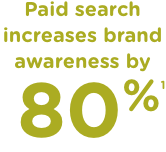
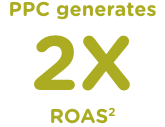

Social Media
Everybody (well, just about everybody) has at least one social media account. Here in America:- 52% use social media to discover new brands and products4
- 78% use social media to learn about new brands5
- 7 is the average number of social media accounts per person6
- 2 hours per day is the average time spent on social media7
Radio
Get ready to have your mind blown. Out of all media, one reigns supreme in weekly frequency among practically all age ranges. It’s not social media. And it’s not TV either. Radio — yes, AM/FM radio — takes the prize. Here are some other head-turning stats showing how radio media buying helps brand awareness:
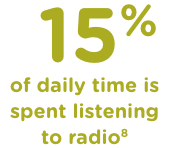
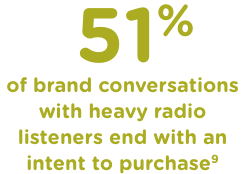
Perhaps the most interesting thing is that, even in today’s non-stop-content-streaming environment, terrestrial radio blows the doors off ad-supported Spotify and Pandora! Just look at the findings of this “share of ear” report.

However, we would be remiss to completely ignore streaming radio, where you can target with almost surgical-like precision. This is especially important if your audience is niche or you want to target a very specific geography.
In short: if you want a cost-effective method of building brand awareness, radio probably deserves consideration.
TV
Nobody can deny TV’s immense branding appeal. Where else can you reach millions of people simultaneously?
At the same time, the overall cost of delivering a broadcast spot is often an obstacle; the message, while reaching countless eyeballs, only appeals to a portion — but that’s changing in an important way thanks to the explosion of addressable TV.
This new technology delivers in ways beyond zoned cable and OTT by giving brands the ability to target not just neighborhoods, but specific households based on select geography, demographics and behaviors.
It’s amazingly exact targeting, amplified because just about anything with a screen can show a commercial nowadays.
There are also other benefits of traditional TV media buying for branding awareness:



Here’s one more important note: TV doesn’t just mean commercials. TV also means branded content within a news program. For example, severe weather break-ins sponsored by a roofing company. And given that the average viewer spends three hours per day glued to their TV, opportunity abounds to build your brand.
So far, we’ve been focusing primarily on interacting with screens.
But we can’t forget about interacting with good ol’ fashioned print, because this medium still packs a branding punch.
For example, did you know that 82% of consumers trust print ads the most when making a purchase decision?
It makes sense. You are consciously deciding which publication to buy and hold instead of being presented a piece of content.
But there are also other numbers that show print media buying enhances brand awareness.

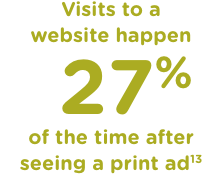

But that’s not all.
Print ads can appear anywhere in a publication: The cover, the centerfold (not that kind) and wraps.
Out Of Home (OOH)
Does it ever seem like you can’t escape brand messaging, even when you’re running errands?
You’ll probably see it on:
- Billboards
- Transit stations
- Public transportation
- Gas station pumps
Businesses advertise on these examples — and many, many more —because OOH is proven to increase brand awareness.

And the potential impact is even greater for retailers.
- 68% of adults notice OOH ads on their way to shopping in-person at a store
- 68% of adults notice OOH ads very close to or right outside a store
- 75% of adults notice OOH ads inside a store
- OOH ads have a moderate or significant impact on 42% of in-person purchase decisions
So, while other mediums might have a little more cache, a well-placed and eye-catching outdoor advertisement has the potential to pay off in a big way.
Ready to Win Your Branding Battle?
Hopefully you now have an idea of how media buying can bolster your brand’s awareness, no matter the medium.
But since the options are seemingly endless and your budget… probably isn’t… you should explore a customized strategy.
Stealth Creative’s media department can help you create one. Drop us a line and we’ll get to boosting your brand’s revenue (and awareness).

Brian Reinhardt
Brian Reinhardt is a Senior Copywriter at Stealth Creative whose first unpublished story was penned at the age of eight. Yes, it involved hoverboards, lasers and robots. His days are filled with researching, content creation and SEO strategy. His nights are spent with family, reading and managing too many fantasy sports teams. Nine is his favorite number.
- https://www.foundsm.com
- https://www.webfx.com
- https://digitalmarketinginstitute.com
- https://www.statista.com
- https://sproutsocial.com
- https://www.forbes.com
- https://www.statista.com
- https://musicalpursuits.com
- https://www.rab.com
- https://www.nyinterconnect.com
- https://www.brandzooka.com
- https://www.newsworks.org.uk
- https://financesonline.com
- https://financesonline.com
While there are plenty of tools necessary to build a strong brand presence, there’s one that everyone needs: A brand voice. You might not think about it, but every single brand has one. Even yours.
What is a Brand Voice?
You might be thinking: “I’ve got a solid business plan and a great product. Do people really care if I have a well-crafted brand voice?” In response to this question, we couldn’t answer loudly enough: “YES!”
Benefits of Owning Your Brand’s Voice
Personality:
Your audience wants to learn about you. Consumers want to know that they are engaging with real people, not robots. By cultivating a personable brand voice, you are more likely to create an emotional connection with your consumer’s subconscious mind. How does this help you? According to Harvard Business School professor Gerald Zaltman, 95% of decisions related to purchases occur subconsciously.*
Consistency:
If your audience is hearing different voices in email messaging versus social media messaging, they’re going to notice the disconnect. This inconsistency can lead them to look in the wrong place for your product or service.
Another benefit of maintaining consistency is conditioning. Let’s go on a field trip, shall we?
Picture it now: You’re back in high school in General Psychology. Today’s lesson is on Ivan Pavlov’s classical conditioning theory. When it comes to exposing your test subjects–err, audience–to stimuli, it is most effective when it is consistent and recurring. If you don’t have consistency in each consumer touch point, you’re essentially starting the process of conditioning over… and over… and over again.
Retention:
Having a consistent brand voice doesn’t just benefit you externally. When your employees see that you’re not just talking the talk, but walking the walk, they’re more likely to believe in the company’s mission, thus improving loyalty. As we know, internal communication and trust are vital when it comes to building — and strengthening — a brand.
How to Create—AND Maintain—a Brand Voice
The best way to craft a strong brand voice is to go back to square one. What is your company’s mission? What do you hope to achieve—for yourself, your brand and your community?
Once you’ve answered these questions, consider who you want to reach. Who is your target audience? (A bonus to fine-tuning your target audience? Knowing where to find them to ensure that all the hard work that you’re putting into your brand voice is heard!)
After learning who your target audience is, you can then begin to consider their personas. What does your customer want? What are their personality types? Their dreams? Their goals? Even go as far as knowing their favorite sports teams? (Kidding. Kind of.)
When you’ve identified the mission, the audience and the personas, you can then test different voice variations. What resonates with this group? How would they characterize your brand voice? Here are some adjectives that can help get you started: Ambitious. Charismatic. Extroverted. Intuitive. Passionate. Trustworthy. Understanding. Witty.
Let’s Get Vocal
Whether you’ve got a start on some ideas for your brand voice or don’t have the first clue where to start, Stealth Creative’s savvy content strategy team is here to lend a hand.
We can help you define tone, feel and personality and start bringing out the key attributes that will help your audience connect directly to the soul of your brand.
But it all starts with a conversation! Get in touch with us today.
You know the saying “It’s what’s on the inside that counts?” That’s far from the whole story, at least when it comes to packaging design.
Just think of the last time you stood in the aisle debating which canned chicken to buy. All things being equal, the can’s label and design probably served as the tiebreaker.
72%
of shoppers say product packaging design influenced their purchase decision
Keep reading to learn which packaging design trends Stealth Creative believes can attract more customers to your brand.
You Are What You Drink
It’s not your imagination: Cans are getting taller and skinnier.
Yes, this is frustrating when you can’t find a snug-fitting coozy. And yes, this trend plays off our subconscious desires.
When we see a slim and sleek can, our brain says “Oh, this must be healthy.” Not only does this satisfy some deep-seated psychology, but it can satisfy your profit margins.
Slimmer packaging also opens more room for your product on retailers’ shelves, which comes with extra benefits like fewer stockouts, lower packaging COGs and more product availability.

Wide Design
10 facings

Slim Design
12 Facings
BOTTOM LINE: There are few things more powerful in marketing than understanding your audience on a deeper level—and turning those understandings into appeals to what they value or desire.
Make It Sustainable
Recyclable materials are so 2019. One of the hottest packaging trends today is sustainability.
Yes, there is a difference.
Recyclable means using materials that can be remade into others.
RECYCLABLE
Plastic
Aluminum
Glass
Paper
SUSTAINABLE
Bioplastics
Wood Pulp
Cotton
Hemp
86%
Source: Trivium Packaging
And when sustainability isn’t an option, big brands are taking leaps towards eco-friendly packaging.
Here’s an example: Sprite recently did away with their iconic green bottles—and we assure you that decision was hotly debated before becoming official. The reason? Clear, transparent bottles are more easily recycled. Now, this isn’t as good as being sustainable—more than a billion plastic bottles are used every day. But we can safely say this enviro-focused trend in general is here to stay.
BOTTOM LINE: Many are starting to take the environment more seriously. And if your brand is philanthropic, nature-oriented or “green,” you need to reflect this in your packaging to boost your brand story’s authenticity.
Speaking of sustainable…
Naturally Colorful
If you want to influence behavior (*cough* sell more products *cough*), color needs to be at the top of your consideration list. For instance, there’s a reason you don’t find many nurseries painted psychedelic orange. It’s not very soothing.
The same principle applies to packaging—which is why you’re probably seeing more of this color lately.
You’re probably also seeing more blues, light greens and neutral browns because those say “earth-friendly” or “sustainable.”

Out of all the packaging design trends, color is probably the most predictable. So, pay attention. Your competition is.
Flashbacks
We don’t know about you, but the past couple of years have been… different. That probably in part explains the upswing in design elements from years past.
Think about it. Retro designs are a backlash. A resistance. These say we want to go back to simpler times with a new face of nostalgia.
Right now, the ’90s are in fashion again. Why? Because the generation that grew up then has more purchasing power… and that decade resonates with them.
So, when our client Urban Chestnut Brewing Company asked us to create packaging for their new line of seltzers, we took a trip down Memory Lane with cans that give a nod to Lemonheads, Hi-C and other staples from that era.

SHOW, DON'T TELL
Now, you might be saying. “This sounds more expensive and involved.” You’d be right. But there’s a big market for it—especially if you’re trying to reach younger consumers.
Perceived
Freshness
Perceived
Tastiness
Perceived
Quality
K.I.S.S.
How can your product stand out when everything else on the shelf is screaming out?
You strip away the excess and minimize your design as much as possible.
So, what does that look like? Let’s use this RX Bar as an example. Nice and clean, right? This package embodies all the best minimal design elements:
- No-wrap around text. If words are that important, make it easy to read all of them.
- Distill the message. Focus on your single most essential feature or benefit.
- Two high-contrast colors. This is proven to grab attention.

Source: shop.rxbar.com
What trend is your packaging missing?
Our package design specialists at Stealth Creative would love to show what your new packaging could look like. Drop us a line at info@stealthcreative.com!
Now that we’ve covered your perspective on fatigue with your own brand and materials, it’s time to dive into the mind of your customer.
Google “fatigue,” and you’ll find several meanings for the word: Exhaustion, extreme tiredness, reduced efficiency.
Every good marketer knows that they must look at industry trends and consumer insights to drive their brand research. However, the process of gathering data to guide your marketing decisions can be pretty intimidating. And while formal focus groups with seasoned moderators can bring enormous insights to your brand positioning strategy, they also bring big price tags.
